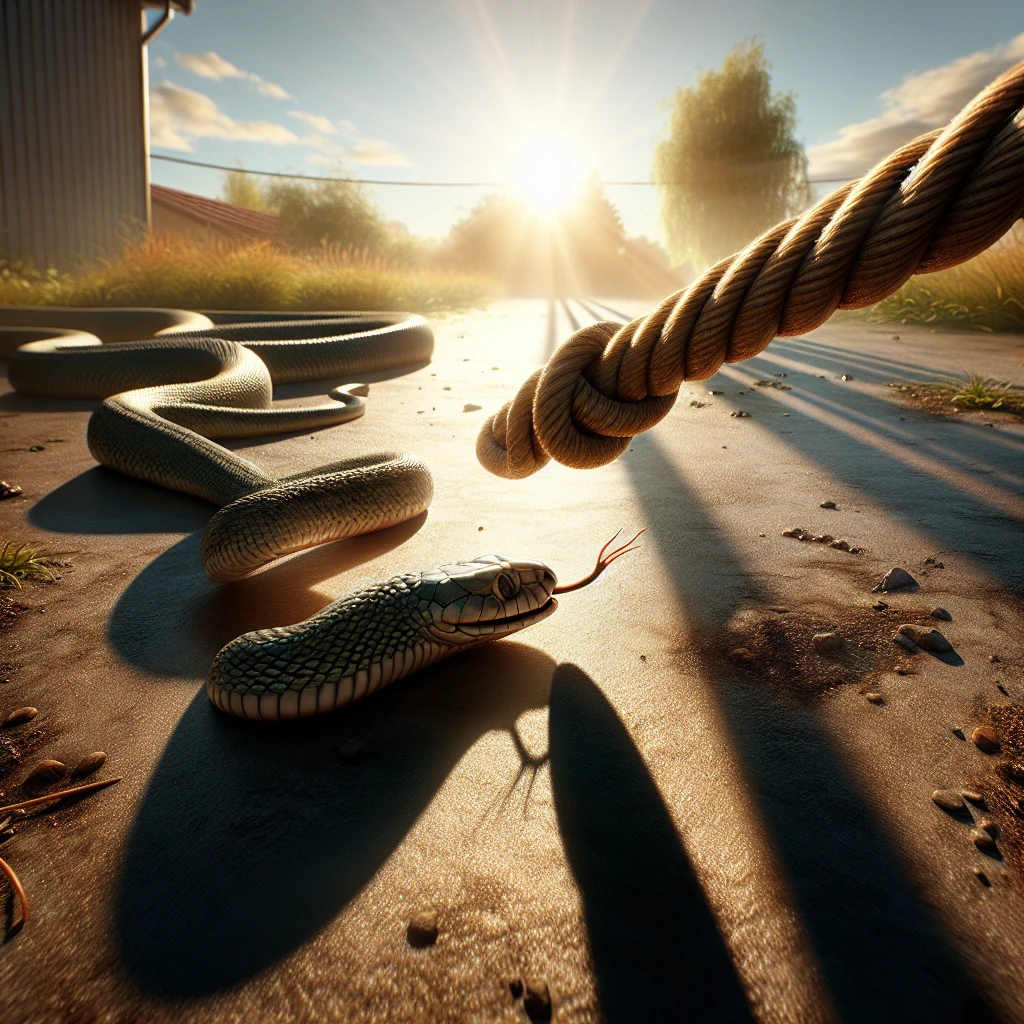Short Answer for Will a Snake Cross Over a Rope
Yes, a snake can cross over a rope because they are capable of and willing to traverse ropes when necessary, showing their adaptability and willingness to cross over obstacles.
Yes, snakes can cross over a rope. There is no evidence or scientific basis to support the myth that snakes will not pass over a rope.
Some people believe that a rope may deter snakes, but snakes are capable of crossing a rope if they desire.
Key Takeaways on Will a Snake Cross Over a Rope
-
Snakes can cross over a rope when motivated to do so, debunking the myth that they will not pass over it.
-
Majority of snakes are not deterred by ropes on the ground, showing their adaptability and willingness to cross over such obstacles.
-
Snakes have a remarkable sensory system including eyesight, hearing, smell & taste, touch, and heat receptors, enabling them to navigate their environment and overcome obstacles such as ropes.
-
Different snake species exhibit diverse habits, but the general consensus is that the majority are capable of and willing to cross ropes.
-
The myth that snakes avoid open spaces and do not like crossing open areas is debunked, as they are driven by their instincts and needs to reach their destinations.

The Myth: Will Snakes Cross a Rope on the Ground?
The Myth: Will Snakes Cross a Rope on the Ground? This myth likely originated from the belief that snakes do not like crossing open spaces. The idea is that a rope laid across the ground creates a barrier that snakes would be reluctant to cross. But the reality is that snakes, driven by their instinct and need to reach their destinations, will cross over ropes and any other objects if necessary.
The Origins Of The Myth
The myth’s origins can be traced back to the assumption that snakes avoid open spaces and would therefore be deterred by a rope on the ground. It’s possible that this idea stemmed from observations of snake behavior in natural settings.
People might have noticed snakes moving along the edges of objects or vegetation, leading to the misconception that they do not venture into open areas.
Is There Any Truth Behind The Myth?
However, the truth is that snakes are not deterred by ropes on the ground. While there have been suggestions and limited studies indicating that some snakes might avoid crossing ropes, the general consensus is that snakes are adaptive creatures and will traverse ropes when motivated to do so.
These reptiles are particularly sensitive to ground vibrations, which guide their movements and often override any deterrence caused by an object like a rope.
Snake Species and Their Habits
When it comes to snake behavior, it’s crucial to understand that different species exhibit diverse habits. While some snakes may display aversion to certain environmental elements, such as ropes, the majority are capable of and willing to cross them.
It’s essential to consider the specific behaviors and environmental adaptations of individual snake species to gain a comprehensive understanding of their habits.
| Snake Species | Rope Crossing Behavior |
|---|---|
| Species A | Will readily cross |
| Species B | May show aversion |
| Species C | Displays no hindrance |
Snake Species and Their Rope Crossing Behavior
The myth that snakes will not cross a rope on the ground is debunked. Snakes, driven by their instincts and needs, will traverse ropes when necessary.
While there may be some species-specific variations in behavior, the consensus is that the majority of snakes will not be deterred by ropes.

Snake Sensory System
Eyesight
Snakes have a fascinating vision system that differs significantly from human eyesight. While snakes do see colors, their visual perception extends beyond the visible spectrum, including ultraviolet and infrared wavelengths.
Unlike humans, their eyes contain more “cone” cells, allowing them to perceive a broader range of colors. The positioning of their eyes on the sides of their heads limits their field of view, making their vision narrower than that of many other creatures.
However, their ability to discern color, movement, and light/dark contrast plays a vital role in their survival in the wild.
Hearing
Unlike mammals, snakes lack external ears, yet they possess all the internal components of the inner ear, including a unique stapes, known as a “columella.” This stapes is distinctive in its connection to the jawbone, enabling snakes to detect vibrations. While their hearing range is limited compared to that of humans, sound waves cause vibrations in a snake’s skull, which are then “heard” by their inner ear.
The banded rock rattlesnake’s rattle, for instance, is generated through the rapid vibration of loose-fitting, interlocking scales on the tail, demonstrating their sensitivity to vibrations.
Smell & Taste
Snakes utilize their exceptional sense of smell to track prey and navigate their environment. Their forked tongues play a crucial role in collecting airborne particles, which are then transferred to the Jacobson’s organ or Vomeronasal organ in their mouth for examination, providing a directional sense of smell and taste simultaneously.
This chemoreception process, a combination of taste and smell, allows snakes to respond to chemical stimuli in their environment, aiding in detecting scent trails left by potential prey.
Touch
Snakes possess a remarkable tactile sense despite the absence of limbs. Their sensory perception through touch enables them to interact with their surroundings and prey.
The supple, scale-covered skin of a snake serves as a versatile sensory organ, allowing them to detect texture, temperature, and vibrations. This tactile sensitivity contributes significantly to the hunting and defensive behaviors of snakes, enhancing their adaptability and survival strategies in diverse environments.
Heat Receptors
One of the most captivating features of a snake’s sensory system is its heat receptors, which enable them to detect infrared radiation. These specialized organs, located within pits on their face, help snakes locate warm-blooded prey, even in complete darkness.
By perceiving thermal gradients in their surroundings, snakes gain a distinct advantage in hunting and navigation, using their unique heat-sensing ability to perceive subtle temperature differences, ultimately ensuring their survival and predatory success.
| Sensory Aspect | Unique Feature |
|---|---|
| Eyesight | Ability to perceive ultraviolet and infrared wavelengths |
| Hearing | Detection of vibrations through their unique inner ear |
| Smell & Taste | Directional sense of smell and taste through the tongue |
| Touch | Tactile sensitivity through supple, scale-covered skin |
| Heat Receptors | Infrared heat-sensing ability using specialized facial pits |

Conclusion on “will a snake cross over a rope”
Yes, a snake will cross over a rope. Despite the myth that snakes will not pass over a rope, there is no scientific basis to support this belief.
Snakes are capable of crossing a rope if they desire, driven by their instinct and need to reach their destinations.
Furthermore, the majority of snakes are not deterred by ropes on the ground. While there may be some species-specific variations in behavior, the consensus is that the majority of snakes will not be deterred by ropes.
Snakes, driven by their instincts and needs, will traverse ropes when necessary, showing their adaptability and willingness to cross over such obstacles.
The myth that snakes will not cross a rope on the ground is debunked. Snakes are adaptive creatures and will traverse ropes when motivated to do so, regardless of the assumption that they do not like crossing open spaces.
Their sensory systems, including eyesight, hearing, smell & taste, touch, and heat receptors, enable them to navigate their environment and overcome obstacles such as ropes.
Frequently Asked Questions
Will a snake crawl across a rope?
Do ropes ward off snakes?
Is it true that placing a rope around your sleeping bag will discourage snakes from crossing it?
Does rope act as a snake repellent?
Reference Links
- https://en.wikipedia.org/wiki/Infrared_sensing_in_snakes
- https://m.facebook.com/savethebuzztails/photos/how-do-snakes-uses-their-senses-of-taste-and-smell-snakes-dont-taste-the-same-wa/2642590569361503/
- https://www.nationalgeographic.com/animals/reptiles/facts/snakes-1
- https://www.quora.com/How-do-snakes-see-Do-they-see-in-color-like-humans-do-or-do-they-only-see-black-and-white#:~:text=And%20not%20only%20do%20snakes,a%20richer%20sense%20of%20color.
